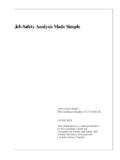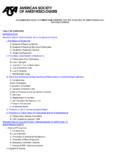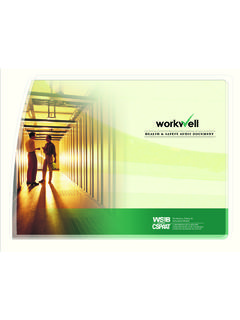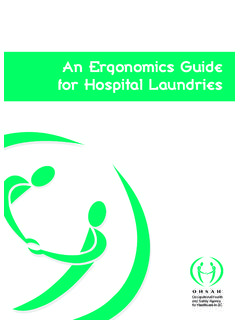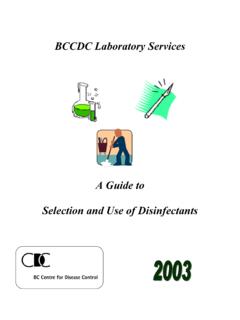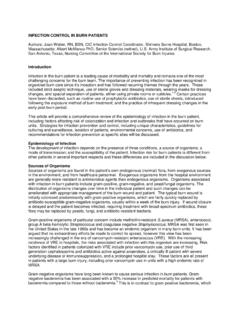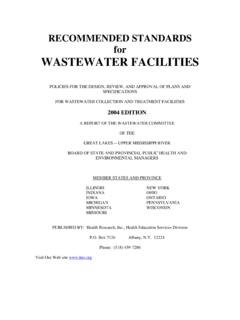Transcription of ASBESTOS CEMENT PIPE: WHAT IF IT NEEDS TO BE …
1 ASBESTOS CEMENT pipe : what If It NEEDS To Be Replaced? ASBESTOS CEMENT pipe : what IF IT NEEDS TO BE REPLACED? G. Eric Williams, Professional Associate/Vice President, HDR Engineering, Inc., Sunset Beach, NC Kent Von Aspern, Senior Project Manager, HDR Engineering, Inc., Walnut Creek, California ABSTRACT: ASBESTOS CEMENT (AC) pipe , also known as transite, was a popular choice of engineers for potable water, sanitary sewer, and storm drain pipelines during the 1940s, 1950s, and 1960s. AC pipe was touted for its light weight and ease of handling, low coefficient of friction (Manning s n = ), and corrosion resistant properties. An estimated 600,000 miles of AC pipe were installed in the and Canada. Due to health concerns associated with the manufacturing process, production of AC pipe ceased in the United States in the early 1970s. The Environmental Protection Agency (EPA) issued a complete ban on all ASBESTOS -containing products in 1979, but was defeated in the Fifth Circuit Court of Appeals and the ban was lifted.
2 The Court did, however, reinforce the EPA s responsibility to regulate ASBESTOS . Hundreds of thousands of miles of AC pipe are beyond or are approaching the end of their 50-year design lives. Two very effective technologies for replacing AC pipe are pipe bursting and pipe reaming. However, existing regulations limit the use of these trenchless construction methods. Many public agency officials and engineers are not familiar with the regulations restricting pipe bursting and pipe reaming of AC pipe . Regulatory application is not consistent from one state to the next, or even within the same state in many instances. Enforcement is occurring much more frequently; however, and it is important for those in our industry to clearly understand the restrictions. This paper will examine the regulations on AC pipe rehabilitation and replacement, evaluate the impacts of the restrictions, and discuss the current position of the regulators.
3 INTRODUCTION ASBESTOS CEMENT (AC) pipe became a viable option for water, wastewater, and storm drainage systems beginning in the mid-1940s. The materials used to fabricate AC pipe included Portland CEMENT , up to 12 percent ASBESTOS fibers, water, and silica or silica-containing materials. The pipe was formed under pressure and heat cured in an autoclave. The presence of the ASBESTOS fibers in lieu of reinforcing steel provided adequate strength with lower weight. In addition to its light unit weight, AC pipe was marketed as having very good resistance to the effects of hydrogen sulfide corrosion and soils that were aggressive to steel, and low operating costs because the smooth walls of the pipe provided low friction factors. The major manufacturers of AC pipe are shown in Table 1. Table 1. Manufacturers of ASBESTOS CEMENT pipe Company Name Headquarters Location CEMENT - ASBESTOS Product Company Woodward, Alabama Certain-teed Products, Company Ambler, Pennsylvania Flintkote Company (Orangeburg Mfr.)
4 Div.) Orangeburg, new york Johns-Manville Company new york , new york AC pipe was manufactured in four different classes, for various applications. Each type of pipe was manufactured to specific ASTM standards. The individual characteristics for each material are shown in Table 2. Each section of pipe and each fitting were marked with the size and pipe class, manufacturer s ASBESTOS CEMENT pipe : what If It NEEDS To Be Replaced? name or trademark, and date of manufacture. Each rubber gasket was also marked with the manufacturer s trademark and date of manufacture. Table 2. Characteristics of ASBESTOS CEMENT pipe Type of pipe Typical Use ASTM Standard Size Range (in.) Crush Strength (lb/ft) Pressure Class (psi) Nonpressure Sanitary sewers C 428 4 42 1,500 7,000 -- Pressure Local water mains, sewer force mains C 296 4 18 4,100 17,400 100, 150, 200 Storm Drain Storm drains C 663 4 42 1,500 3,750 -- Transmission Water mains C 668 6 42 2,000 42,000 300 900 Due to its light unit weight, relatively low installation cost, superior corrosion resistance, and low friction factor (Manning s n = ), AC pipe was very popular during the 1950s, 1960s, and early 1970s.
5 Vitrified clay pipe provided a competitive alternative for use in sanitary sewer systems, but AC pipe soon became the pipe of choice for water and storm drainage systems. A survey conducted by the American Water Works Association (AWWA) in 2004 found that, on average, AC pipes constitute approximately 15 18 percent of the nation s water distribution and transmission systems. In North Carolina, AC pipe comprises nearly 5,000 miles of pipeline or approximately percent of all water mains installed. The amount of AC pipe installed in various entities within North Carolina ranges from zero to ninety-eight (98) percent. This illustrates that there is a substantial quantity of AC pipe installed in North Carolina and is quite prevalent in some communities. Communities that experienced significant growth during the 1950s and 1960s, however, constructed their infrastructure systems when the use of AC pipe was prevalent.
6 These cities have percentages of AC pipe that are much higher than the national average, especially if one or more AC pipe manufacturing facilities were located nearby. Through our research, we found that AC pipes comprised from 50-80% of typical storm drain systems in the western U. S. and Canada; water systems included 40-75% AC pipes; sewer systems included 10-25% AC pipe (mostly in force mains). Usage rates as found through our literature search for the various systems are shown in Figure 1. As a comparison, the AWWA survey of 50 responding communities (mainly large municipalities in the eastern U. S.) reported that 15% of infrastructure systems are comprised of AC pipe as a national average. Overall, it is estimated that more than 600,000 miles of AC pipe are in use throughout the and Canada. Figure 1. ASBESTOS CEMENT pipe was used extensively in water and storm drainage systems built between 1950 and 1969 0 20 40 60 80 100 Storm Drains Water Systems Sanitary Sewer North America Percent ASBESTOS CEMENT pipe : what If It NEEDS To Be Replaced?
7 Under certain conditions, AC pipe has experienced failures at rates that are similar to other pipe types during their 50-year design lives. However, many public agencies have reported significantly higher failure rates for AC pipe than for other pipe materials. Ironically, the major factor in predicting failures of AC pipe appears to be aggressive soils one of the conditions that AC pipe was supposed to protect against. Overall, however, studies have shown that the failure rate for AC pipe increases dramatically with age. After 50 years of use, AC pipe failure rates are about one per year per mile of pipe . THE HISTORY OF ASBESTOS REGULATION In 1973 the National Emissions Standards for Hazardous Air Pollutants (NESHAP) was implemented by the United States Environmental Protection Agency (EPA) when it was determined that ASBESTOS was a leading contributor to asbestosis and certain forms of cancer.
8 Through NESHAP, the EPA sought to protect the public by controlling exposure to ASBESTOS during the milling, manufacture, common use, spraying, renovation, demolition, and disposal of more than 3,000 ASBESTOS -containing products. Effectively regulating such a large class of diverse products proved to be a daunting task. In 1979 the EPA announced its intent to ban all ASBESTOS -containing materials. By 1986 the EPA proposed a rule to ban ASBESTOS . The EPA s ASBESTOS Ban and Phaseout Rule was published in the Federal Register1 in 1989, proposing to eliminate all ASBESTOS -containing materials in three stages between 1990 and 1997. The ASBESTOS Information Administration and the ASBESTOS Institute (with major funding from the government of Canada) conducted significant lobbying efforts against the ASBESTOS Ban and Phaseout Rule.
9 One large manufacturer of ASBESTOS -containing products, Corrosion-Proof Fittings, successfully sued the EPA to block implementation of the ban. The Fifth Circuit Court of Appeals ruled that the EPA had failed to present a compelling case for banning all ASBESTOS -containing materials. The Court did, however, reinforce the EPA s responsibility to regulate ASBESTOS , and new products containing ASBESTOS were banned. The impact on the ASBESTOS pipe industry was uncertainty and fear. After 1973, the ASBESTOS fiber content in AC pipe was reduced from 12 percent to less than percent. By the 1980s the popularity of AC pipe had waned dramatically due to fears of liability and the availability of PVC pipe . Manufacturers stopped producing AC pipe in the United States; however, the machines were moved to other countries (including Mexico and Saudi Arabia), and AC pipe is still produced and available today.
10 ASTM Subcommittee remains active and tasked with maintaining a series of ASTM specifications related to the manufacture, installation, and testing of AC pipe . Table 3 lists the ASTM specifications for AC pipe . Table 3. ASBESTOS CEMENT pipe ASTM Specifications Specification Number Subject C296 Pressure pipe C428 Non-pressure Sewer pipe C458 Organic Fiber Content C500 Test Methods for AC pipe C663 Storm Drain pipe C668 Transmission pipe C966 Installing AC Non-pressure pipe D1869 Rubber Rings for AC pipe Table 4 shows the AC pipe standards promulgated by the American Water Works Association (AWWA). In November 2008, the AWWA withdrew its AC pipe standards. ASBESTOS CEMENT pipe : what If It NEEDS To Be Replaced? Table 4. ASBESTOS CEMENT pipe AWWA Specifications Specification Number Subject C400 Pressure pipe , 4 -16 C401 AC pipe Selection, 4 -16 C402 Pressure pipe , 18 -42 C403 AC pipe Selection, 18 -42 REGULATIONS FOR AC pipe In most states, public agencies are not required to remove and replace AC pipe .
